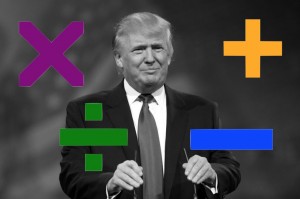Trump and His Supporters Have a Problem With Basic Math
 Math is hard. For some people, math is really hard. The evidence strongly indicates that Donald Trump and most of his supporters belong in that latter group, and it has had profound implications on this election and the Republican Party (maybe this finally also explains why Trump thinks he is worth $10 billion when no one else does).
Math is hard. For some people, math is really hard. The evidence strongly indicates that Donald Trump and most of his supporters belong in that latter group, and it has had profound implications on this election and the Republican Party (maybe this finally also explains why Trump thinks he is worth $10 billion when no one else does).
Here are some of the seemingly simple numbers and equations which, because Trump’s supporters seem unable or unwilling to properly comprehend them or foresee their predictability, have allowed a horrendous candidate like Hillary Clinton to be on the verge of the presidency.
< 270 = Loss: 270 is the number of Electoral College votes to win the presidency. Trump lied in the primaries (with the “conservative” media doing nothing at all to correct him) and claimed that he would have more paths to getting there than anyone else because he would “change the map.” He promised he would win New Hampshire, Michigan and Pennsylvania, while being competitive in New York, Illinois, and California.
We now know that Trump only has one remotely logical way to get these 270 votes. He must win all of the “Romney” states (including several of which where he is currently behind) and then add Florida, Ohio, and Pennsylvania. Not only is this path inherently perilous because it provides literally zero margin of error for a candidate who is extremely error-prone, but there is currently absolutely no evidence that any part of it is realistic. Even if you give him every possible benefit of the doubt and those three “Obama” states are somehow 50/50 propositions, statistically Trump only wins all three of them just one out of eight times.
66 million > 14 million: Trump and his supporters love to brag about the record 14 million votes he got in the primaries (he also had a record number of Republicans vote for someone else). However, they seem oblivious to the reality that primaries and general elections are completely different entities. They are very much like comparing lakes with oceans.
While Trump may have 14 million strong supporters (and if you didn’t vote for him in the turbo-charged primary you are probably not much of a backer at all), Barack Obama won 66 million votes in 2012. This not only indicates that Trump would somehow need to find at least 40 million voters who didn’t back him in the primaries (obviously the popular vote doesn’t determine the winner, but there is a very strong correlation), but also how many general election voters are very pre-disposed to voting for Hillary.
47% > 42%: In 2012, Mitt Romney was destroyed by the news media for saying, quite correctly, that 47% of voters are very likely to vote Democrat in any national election because they are literally “invested” in the government supporting them. That number is interesting because it also happens to be Hillary’s current average of support head-to-head against Trump.
It is my belief that, barring a debate catastrophe for Hillary, a colossal news event, or one of the “third-party” candidates suddenly gaining huge traction, Hillary’s floor is, at worst, in the range of 47% (45% if Trump produces remarkable turnout). This is a massive math problem for Trump because it is becoming more and more apparent that his ceiling of support, in a remotely normal turnout election, may be as low at 42%, which is a number which keeps coming up a lot for him in recent polls and that is consistent with…
56% > 43%: One of the primary reasons that Trump’s ceiling is both low and quickly hardening, is that so few people perceive him as “qualified” for the job in comparison to Hillary. A Fox News poll out last week indicated that 56% see her as “qualified,” while only 43% think the same about him. Other recent polls indicate that the disparity on this issue, depending on how the question is phrased, could be even larger (ABC put it at 60-38, a catastrophically bad number for Trump).
I have said many times that the amount of people who see Trump as “qualified” is the key number in the election. If you don’t see him as overcoming that “job application” hurdle, then you simply are extremely unlikely to vote for him (unless, as some may actually do, you are just looking for the most entertaining candidate).
This is why Trump’s “ceiling” number is almost identical and currently far too low to beat Hillary. It is also a figure which is next to impossible to change at this point. For voters who see him as “unqualified” and Hillary as “qualified,” Trump might as well be a eunuch trying to marry a woman who is desperate to have kids. There is just nothing he can do about it, especially in only three months.
6% = 8 million: Trump is currently behind, depending on how you measure it, by at least 6% nationally. It appears to me that most people, especially Trump supporters, don’t fully understand what that means numerically. It appears they think of 6% as a rather small and easily overcome deficit, as if he was down 6 points in a football game. This is simply not accurate.
The better way to think of 6% nationally is that Trump is at least (give or take, depending on turnout) eight million votes behind. That is an enormous deficit, especially with an extremely distracted voting populace and a hopelessly fragmented media, most of which is dead-set against him.
Now, if there were four million committed Hillary voters waiting to be sweet-talked with just one more rendition of “Make America Great Again,” then this might not be so daunting. However, there is zero indication or logic that significant numbers of those who currently identify as a Hillary voter would ever flip to Trump.
Nor are there eight million “Republicans” who are both undecided and not in the “Never Trump” category. This means that, statistically a large majority of those eight million would have to come from the very nonpartisan, super-low-info “independent” voters who Trump can’t reach via conservative media and who are usually influenced by the entertainment media, which is even more openly hostile to Trump and sympathetic to Hillary than the news media is.
1 = 1: Last week Trump lamented at one of his YUGE rallies that he just can’t understand how he could be losing when his crowds are so much bigger than Hillary’s. His supporters have used this cue from their emperor with no clothes to conclude that the polls (the very same polls their king used to convince them in the primaries that he was for real) are simply wrong, or “rigged.”
This might be the central math problem at the heart of “Trumpsanity.” Trump supporters honestly don’t seem to realize that the vote of a person who goes to multiple Trump rallies, follows his Twitter feed religiously, voted for him in the primary, and watches Sean Hannity every night while wearing their “Make America Great Again” hat, counts exactly the same as the person who gets driven to the polls after telling a Clinton campaign worker, “eh, I guess I’ll vote for Hillary, Trump seems scary.”
In fact, if that first person lives in Oklahoma and the second one lives in Ohio, Florida, or Pennsylvania, only the second voter really counts at all, in the end. The bottom line is that, while voter enthusiasm is vital in a primary, it is less so in a general election where most of the population voters no matter what. In a presidential election it is far better to have tens of millions of “I guess?” voters who are frightened by the same attributes which give the other guy millions of “hell yes!” supporters.
All of this, of course, adds up to a near certain Hillary victory. Something which easily could have been avoided if the right people had simply understood some basic math. There is, after all, a good reason why Trump once declared after a big primary victory, “I love the poorly educated!”
—
John Ziegler is a nationally-syndicated radio talk show host and documentary filmmaker. You can follow him on Twitter at @ZigManFreud or email him at johnz@mediaite.com
This is an opinion piece. The views expressed in this article are those of just the author.




